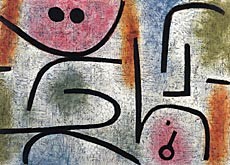
Exhibition explores Klee’s difficult last years

The final decade in the life of Swiss-born artist Paul Klee is the subject of a new exhibition at the Beyeler Foundation in Riehen near Basel.
Its main focus is how the hardship Klee suffered during this period brought about a dramatic transformation in his work.
During the period 1930 to 1940, the artist’s life was disrupted by two events.
In 1933, the Nazi Party expelled Klee from his teaching post at the Düsseldorf Academy, where he had taught since 1931.
Later that year, he left Germany and returned to Bern, where he had spent his childhood.
Then, in 1935, he became seriously ill, and was diagnosed a year later with a terminal illness. His illness severely limited his ability to paint at times, but when his condition stabilised, he had some of the most productive moments of his career.
Ernst Beyeler, founder of the Beyeler Foundation and long-time collector of Klee’s art, says he finds this period of the artist’s work the most interesting.
“It’s the most impressive and productive period, not only in form but also in size,” Beyeler told swissinfo. “His experiences brought him to a new, stronger level – that he found his way to a bigger vision is remarkable.”
Light to dark
Klee’s paintings before 1933 mainly consisted of bright colours and delicate lines. Some of his work during this period used the so-called pointillist style, in which small dots take the place of lines to create forms on the canvas.
But as his life became disrupted, light and delicate paintings gave way to darker, stronger colours and crude shapes painted with thick black lines.
Klee used the new styles to convey anxiety over his illness and his political persecution. Titles such as “Gate to the depth” (1936), “Death and fire” (1940) and “Broken key” (1938) are representative of the period.
Beyeler says Klee showed an acute awareness of the changing political landscape centred on Nazi Germany.
“Klee sees that the world is changing and going over to a very dangerous and awful period,” he said. “[His art] reflects the anxiety and the danger which the world is heading towards. His prophesy turned out to be right.”
Approaching the afterlife
As Klee approached the end of his life, a different style with a more ethereal theme emerged.
Between 1937 and 1940, images of angels increasingly featured in his work. Klee uses the angels, Beyeler says, to tackle questions of mortality.
“Klee’s approaching death has a big influence on his work,” Beyeler said. “It brings his work to other dimensions, it’s wonderful that he goes beyond two dimensions.”
“Paul Klee: fulfilment in later work” runs at the Beyeler Foundation until November 9.
swissinfo, Joanne Shields
In 1933, Klee was dismissed from his teaching post at Düsseldorf Academy and subsequently moved back to Bern.
Klee fell ill with bronchitis and measles in 1935, which were later diagnosed as symptoms of scleroderma, a terminal illness.
He was bedridden until 1936, when he resumed painting on a limited basis.
Klee’s condition had stabilised by 1939, allowing him to paint more often.
He died in June 1940 from cardiac paralysis.

In compliance with the JTI standards
More: SWI swissinfo.ch certified by the Journalism Trust Initiative

























You can find an overview of ongoing debates with our journalists here . Please join us!
If you want to start a conversation about a topic raised in this article or want to report factual errors, email us at english@swissinfo.ch.